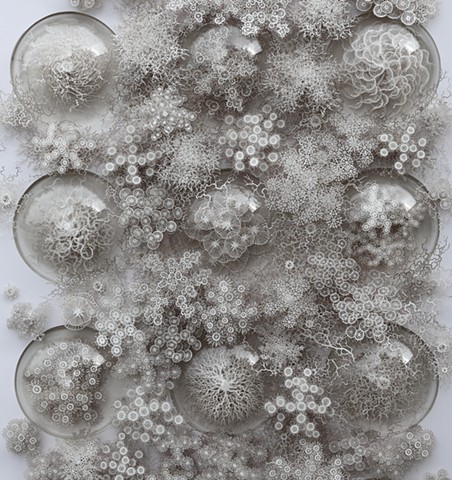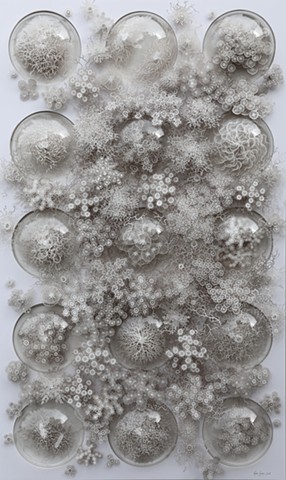Control X
Control X2_17 is a laser-cut paper sculpture that both aesthetically references and critically examines the scientific impulse to classify, categorize, and contain. The work, composed of multiple intricate organic forms enclosed within circular petri-dish-like structures, appears at first to celebrate taxonomy—the systematic study of naming and organizing biological life. Yet on closer inspection, it undercuts and destabilizes the very logic of scientific control and containment it seems to mimic.
Taxonomy as an Illusion of Control
Each “specimen” in Control X2_17 recalls microbial, botanical, or marine life—corals, spores, diatoms, or even neural patterns—but none correspond precisely to any real organism. Instead, the work offers an imaginary taxonomy: forms that gesture toward natural science without conforming to its empirical boundaries. This blurring between the real and the fictional reveals a fundamental critique: the act of classification is not neutral. It reflects human desire to impose order on an unruly, interrelated world.
The petri dishes, a recurring motif in this work, symbolize containment and observation—the basic operations of scientific inquiry. But their transparent domes do not seal or isolate these forms with clarity. Instead, the layered, filamentary networks seem to overflow and interlace visually. The sheer complexity and exuberant proliferation of forms refuse to be pinned down or systematized. The viewer is drawn into a paradox: a specimen culture that cannot be stabilized.
Destabilizing the Scientific Gaze
In mimicking the visual codes of microscopy and specimen display, the work engages with Foucauldian critiques of the scientific archive as a tool of power and knowledge production. It appropriates the language of order—grids, repetition, clear containment—only to destabilize it through baroque intricacy and indeterminate morphology. What emerges is a counter-archive, where knowledge is not fixed but evoked through aesthetic uncertainty.
Each form is so meticulously crafted that the precision becomes a kind of delirium; the clarity of the cut is at odds with the ambiguity of what is represented. In this way, the anxiety behind the Enlightenment project of classification is revealed—a recognition that nature always exceeds the categories imposed upon it.
Aesthetics of Complexity and Resistance
At a deeper level, Control X2_17 can be read as a meditation on complexity and resistance. In resisting clear identification, these forms suggest that living systems—and by extension, human bodies, ecosystems, and even ideas—cannot be fully diagrammed or mastered. The very notion of "control" is placed in ironic tension with the unruly proliferation of organic complexity.
The use of paper—fragile, ephemeral, and hand-assembled—furthers this critique. Unlike laboratory plastics or sterile glass, paper speaks of vulnerability, decay, and impermanence. The materials subtly remind us that even the most rigorously constructed knowledge systems are precarious and subject to collapse.
In sum, Control X2_17 is not merely a celebration of biological beauty; it is a sly and subversive critique of the scientific desire to organize life into neat hierarchies. It stages an aesthetic rebellion against rigid taxonomies, offering instead a visual experience that is immersive, unstable, and beautifully unknowable.

